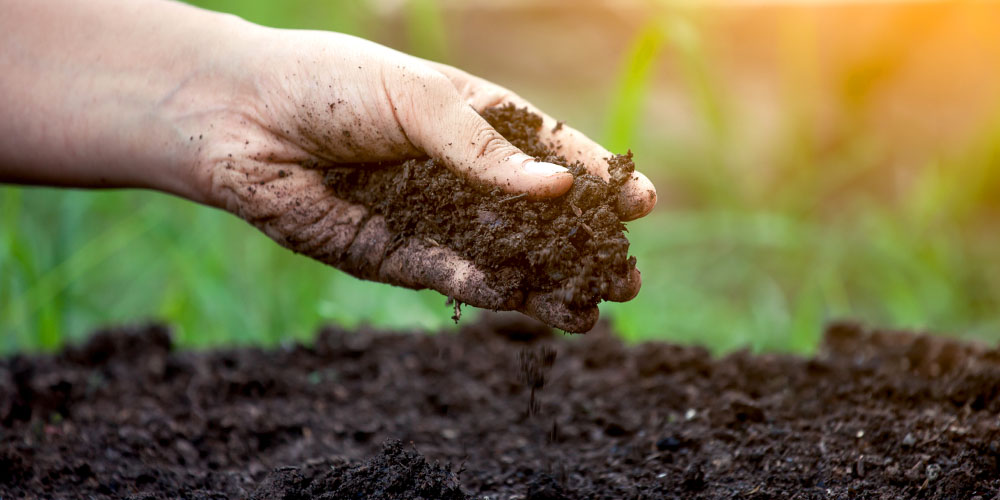Fall Patio Pot Workshop Now Open!
Register Now
If you’re new to gardening, you may not realize that there are actually six different types of soil. In order for you to get the most out of your garden, it’s important to understand which type of soil you’re working with and how it might affect the growth of your plants this growing season. Read on to learn more about the different soil types.
Clay soil can be rich in nutrients but tends to retain water a little more than we’d like. This leads to poor drainage and air circulation, which can negatively affect plant growth. Clay soil feels sticky and lumpy if wet and hard as concrete when it dries. This soil type can affect plant growth in two ways: by depriving the plant roots of oxygen and preventing roots from passing through. However, this can be corrected by mixing in organic matter like compost or straw. Certain varieties of shrubs and perennials like dogwood, aster, and daylilies can thrive in heavy clay soil.
Sandy soil is different in comparison as it has the exact opposite issues that clay soil has. It’s much lighter, dries faster, and is not as rich in nutrients. This is primarily caused by how easily it drains, which allows nutrients to wash right out of the soil. Plant growth can be affected because they’re simply not getting the water or nutrients needed to thrive. A good rule of thumb when dealing with sandy soil is to amend it with organic materials, such as compost, fertilizer, mulch, and manure. Many vegetables, such as carrots, zucchini, and tomatoes, prefer to grow in properly amended sandy soil.
Silty soil is easy to work with, retains moisture properly, and is quite rich in nutrients. Silty soil will, however, often need added drainage for it to work properly as a growing medium in your garden. Improper drainage can affect the growth of your plants if they are too heavily saturated with moisture. An easy way to add drainage to silty soil is by mixing in organic matter like compost or dried leaves. You can never really go wrong with adding compost to your garden, as it will add rich essential nutrients that help your plants thrive. Most fruits and vegetables love silty soil, as do many shrubs, perennials, and even trees.
Peat soil can be tricky as it’s a highly acidic soil type—quite different from the others on this list. For most plants, peat soil is a hostile environment and significantly affects their growth. You’ll need to increase the nutrient levels, add drainage, and raise the pH level. A simple way to make the soil more alkaline is by adding lime or glacial rock dust. Mixing in compost does double duty by adding nutrients and providing drainage at the same time. Peat soil can still be a great growing medium once it’s been properly amended, and there are also several plants (including some gorgeous shrubs) that adore acidic soils. Shrubs such as rhododendrons, blueberries, and witch hazel can grow happily in peat-heavy soil.
Chalky soil is another type that will affect plant growth but in a much different way compared to other soils. It’s often found overlying limestone bedrock and tends to be clumpy and naturally stonier than other soils. It also tends to be very alkaline, which can be an obstacle for growing some plants that prefer a more neutral soil. Organic matter like compost or well-rotted manure can help to balance the pH of this soil type while also improving moisture retention. Lilac bushes, weigela shrubs, and mock oranges can do well in chalky soil, as well as spinach and cabbage.
Loamy soil is easily the most coveted natural garden soil. It’s a proper mix of clay, sand, and silt, which gives it perfectly adequate moisture retention, drainage, and rich nutrients, all of which are ideal properties for optimal plant growth. However, you’ll still need to replenish these nutrients throughout the growing season by adding organic matter such as compost and manure. It also won’t hurt to keep an eye on the pH levels of your garden soil as loam can lean more towards the acidic side. Compared to different types of soil, loamy soil is definitely one of the easier mediums for optimal growth in most plants.
You can use soil test kits to assess the pH levels and nutrient levels in your soil to make sure it’s in top growing condition. While each plant has its own soil pH preference, nutrients and minerals naturally thrive at a pH level between 6.5 and 7, which is an ideal balance to keep most garden plants happy. It never hurts to test your soil multiple times during the growing season!
Now that you have an idea of the different types of soil, how they affect plant growth, and how to amend your soil if it’s just not quite right, you’re well-equipped to get your hands dirty and start planting. To build the best garden soil in Northwest Arkansas, stop in at one of our garden center locations; we’d be more than happy to assist you with all your soil needs!